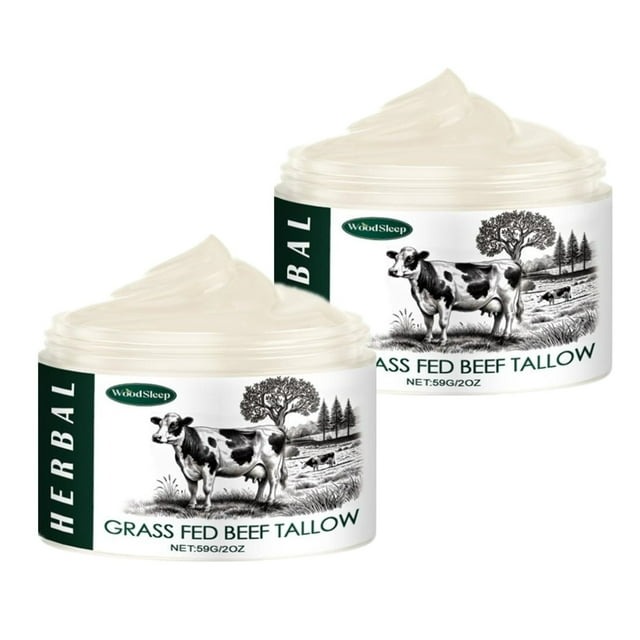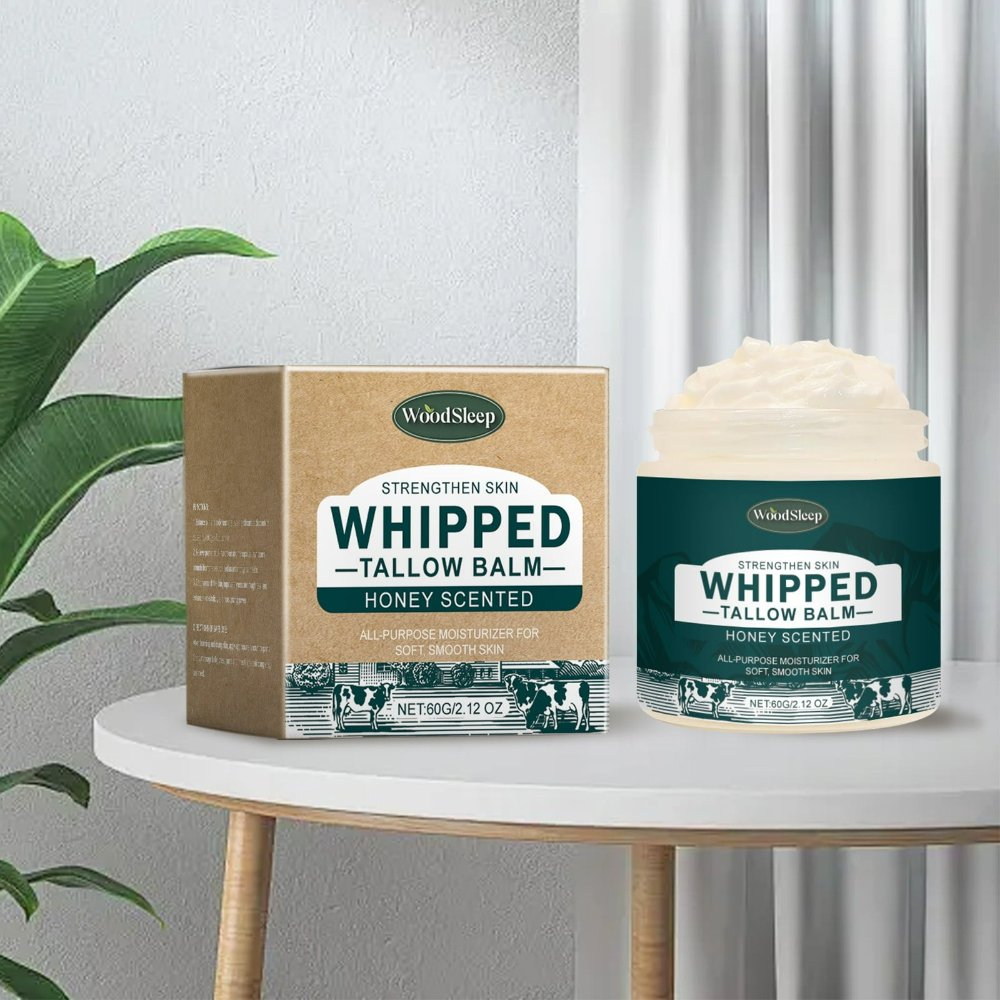What Is Tallow and Its Composition
Tallow is a form of rendered fat from animals, primarily cows or sheep. It consists mainly of triglycerides, which are fats that your body can readily use. This substance has a complex composition, including stearic, palmitic, and oleic acids. These are types of saturated and monounsaturated fats recognized for their stability and their affinity with human skin. Tallow also contains fat-soluble vitamins A, D, E, and K, which are vital for skin health.
People often advocate for tallow in skin care because of its bioavailability. This means the skin can easily absorb it, allowing deeper penetration of nutrients. When incorporated into skin care, tallow works to moisturize, protect, and repair the skin at a cellular level. Its composition closely resembles human sebum, the skin’s natural oil, promoting compatibility and reduced risk of irritation. In summary, tallow skin care benefits from a unique blend of fats and vitamins tailored for optimal skin health.

Tallow vs. Plant-Based Oils in Skin Care
When exploring fat sources in skin care, we often come across a comparison between animal-derived tallow and plant-based oils. It’s crucial to understand their differences to make informed decisions for your skin’s needs.
Tallow offers deep hydration due to its molecular makeup, which closely resembles human sebum. This similarity means tallow is naturally absorbable, leading to rich, lasting moisture. Comparatively, plant-based oils, things like coconut oil and shea butter, are packed with essential fatty acids and antioxidants. These oils often claim fame for their ability to nourish and soothe the skin with their unique properties.
Moreover, some plant-derived oils have higher linoleic acid content which can be beneficial for acne-prone skin. This contrasts with tallow’s oleic acid prevalence, more suited for dry or aging skin types. However, one size doesn’t fit all in skin care. Tallow skin care might excel in one area where plant-based oils shine in another.
There’s also the sustainability angle. Tallow, as a byproduct of the meat industry, utilizes resources that might otherwise go to waste. Meanwhile, the production of certain plant-based oils can demand extensive land use and may contribute to deforestation.
In conclusion, both tallow and plant-based oils have their place in skin care regimens. The choice between them depends on your skin type, ethical stance, and environmental considerations. By considering these factors, you can select the best option that aligns with your personal skin care philosophy.
Historical Uses of Tallow in Skin Care
Tallow has been used for centuries in skin care. In ancient times, people discovered that animal fats could provide a protective layer for the skin. They used tallow to soothe and moisturize, especially in harsh climates. Historically, tallow found its place in balms and salves, catering to everything from chapped hands to minor wounds.
In Egypt, tallow was combined with herbs and plants to create ointments. These were applied for cosmetic benefits and to guard against the dry desert environment. In Rome, tallow-based creams served as early forms of cold creams for preserving the skin’s beauty. Across different cultures, tallow remained a staple for its hydrating properties.
During the Middle Ages, tallow played a role in skin protection for the workforce. Farmers and craftsmen often faced tough conditions. Tallow skin care provided a barrier against the elements and helped to keep skin supple. Later, as the medical field advanced, tallow was used in remedies. This was due to its purported healing properties.
Through the ages, tallow skin care maintained its reputation for being nourishing and easily accessible. It aided those in need of reliable skin care solutions. As we understand more about its composition and skin-matching nutrients, it’s clear why tallow’s historical use in skin care established its lasting presence. The use of tallow in today’s skin care routines is a nod to its time-tested efficacy and natural origins.

Nutritional Profile of Tallow and Its Benefits for Skin
Tallow boasts a range of nutrients that are excellent for the skin. Its rich in fat-soluble vitamins A, D, E, and K. Beyond vitamins, tallow’s fatty acid profile is particularly aligned with that of human skin. The predominance of stearic, palmitic, and oleic acids aids in restoring the skin’s natural barrier. These acids moisturize deeply, prevent moisture loss, and offer anti-inflammatory benefits. This makes tallow an excellent choice for those with dry or mature skin.
Another important element is tallow’s bioavailability, which refers to its absorption rate into the skin. Since tallow closely mimics human sebum, it’s readily accepted by our skin. This means that all the beneficial nutrients tallow contains are more effectively utilized.
For centuries, people have turned to tallow skin care for its natural ability to nourish and protect the skin. In the modern age, understanding its nutritional profile underscores why it remains a valuable addition to skin care routines. Whether you’re looking to hydrate dry skin, soothe irritation, or simply maintain healthy skin, tallow offers multi-faceted benefits grounded in nature’s wisdom.
How Tallow Benefits Different Skin Types
Tallow skin care offers unique benefits for various skin types. Its composition of fatty acids and vitamins can address different concerns effectively.
For dry skin, tallow’s saturated fats work wonders. They provide deep moisture and protect the skin’s barrier. This can reduce flakiness and soothe rough patches.
Those with oily skin might shy away from tallow, fearing excess grease. However, tallow’s similarity to sebum can actually help regulate oil production. It offers balanced hydration without clogging pores.
If you have sensitive skin, tallow is gentle and less likely to cause irritation. Its natural composition aligns with skin’s own oils, reducing possible reactions.
For aging skin, tallow skin care is a boon. It helps maintain elasticity and moisture. The vitamins in tallow promote regeneration, which can lessen the appearance of fine lines.
Combination skin types can also benefit from tallow. It moisturizes dry areas while not overwhelming oily zones. By doing so, it brings harmony to your skin’s complex needs.
People with acne-prone skin should use tallow selectively. As it’s more occlusive, it might not suit all acne conditions. Always patch test first to see how your skin reacts.
In summary, tallow skin care has something to offer everyone. From deep hydration to gentle care, it’s versatile in addressing different skin needs.

Tallow in Modern Skincare Products
The re-emergence of tallow in modern skincare is remarkable. Many brands now recognize tallow’s unique properties and are incorporating it into their products. Tallow is used in a variety of items such as moisturizers, balms, and soaps. Its ability to deeply nourish the skin is a standout feature in creams for face and body care.
Today’s consumers are also keen on clean, minimalist ingredients. Tallow fits this trend perfectly, as it is a single, natural component that offers multiple benefits. This makes it highly appealing in the creation of products for the ‘clean beauty’ niche. Brands that prioritize natural and sustainable ingredients often include tallow in formulations, tapping into a market of eco-conscious buyers.
Moreover, innovative skincare companies are blending tallow with other beneficial ingredients. They might combine it with essential oils for added fragrance and skin-healing properties. Some artisanal makers infuse herbs or botanicals to enhance the benefits, appealing to those seeking holistic skin remedies.
Acknowledging varying consumer preferences, there are now tallow-based products for different skin types. For example, products with lighter concentrations are available for those with oily or combination skin. On the other hand, more intensive, rich formulations cater to those with dry or mature skin.
When browsing skincare lines, one might come across labels stating ‘grass-fed tallow.’ This denotes a quality product since grass-fed sources of tallow retain higher levels of nutrients which are beneficial for the skin. It’s a detail that matters to consumers who value the origin and quality of the ingredients in their skincare regimen.
To summarize, tallow’s incorporation into modern skincare products reflects an appreciation for its historical use and acknowledges its potent benefits. With clean beauty on the rise, tallow stands out as a multi-faceted and sustainable option suited for a variety of skincare needs.
DIY Tallow Skin Care Recipes
Creating your own tallow skin care products is both rewarding and beneficial. Here are some simple recipes to start exploring the versatile applications of tallow in your skin care routine.
Tallow Balm for Dry Skin:
To make a moisturizing balm, melt equal parts of tallow and coconut oil in a double boiler. Once liquid, remove from heat and let it cool slightly. You can add a few drops of lavender or chamomile essential oil for fragrance and added skin-calming properties. Stir well and pour into a jar to set. Apply to dry areas as needed for intense hydration.
Tallow Lip Conditioner:
Combine two teaspoons of tallow with one teaspoon of olive oil or almond oil. Gently melt them together and pour into small lip balm tubes or tins. Once cooled, use it to keep your lips soft and supple.
Whipped Tallow Body Butter:
Whip up a fluffy and light body butter by combining melted tallow with a carrier oil like jojoba or sweet almond oil. Allow the mixture to partially solidify, then whip it with an electric mixer until it reaches a creamy consistency. Customize it with essential oils of your choice. Store in a cool place and enjoy the luxurious feel after a bath or shower.
Tallow Face Cream for Mature Skin:
For a rich face cream, mix tallow with argan oil, known for its anti-aging properties. Melt the tallow, blend in the oil, and let the mixture cool. Add a few drops of rosehip seed oil for its skin-rejuvenating benefits. Apply nightly to help reduce the appearance of fine lines and wrinkles.
These DIY recipes are a starting point, and you’re encouraged to experiment with different essential oils and carrier oils to suit your skin care needs. As you delve into making tallow skin care products, remember to source high-quality, grass-fed tallow for the best results. Enjoy the process of crafting your own natural, potent products that harness the historical benefits of tallow.
Ethical and Sustainable Aspects of Using Tallow
The use of tallow in skin care is not only about its hydrating benefits. It also involves ethical and environmental considerations. Tallow comes from animal sources, which raises important ethical questions. For those who follow vegetarian or vegan lifestyles, tallow is not an option. They prefer plant-based alternatives that align with their principles. However, for others, using tallow is a way to honor the whole animal. It ensures that nothing from the livestock goes to waste.
From a sustainability perspective, tallow has a strong standing. It is a byproduct of the meat industry, already existing as a result of meat consumption. Utilizing tallow reduces waste and can be seen as a respectful use of the animal’s resources. Unlike some plant-based oils, tallow doesn’t require additional farming or deforestation. This minimizes its ecological footprint.
Using tallow also supports local farmers and butchers. It can provide an economic boost to these important community members. When you choose tallow products, especially from grass-fed sources, you’re often supporting sustainable agricultural practices. Grass-fed animals typically graze on land that might not be suitable for crops. This promotes biodiversity and soil health.
For eco-conscious consumers, the transportation impact is another factor. Locally sourced tallow reduces the carbon emissions tied to shipping. This is unlike many exotic plant oils that travel great distances to reach users.
In summary, when considering tallow skin care, think about the bigger picture. Reflect on your values and the world you want to support. Tallow can be an ethical choice that promotes sustainability, supports local economies, and respects animal life. It’s a traditional ingredient with modern-day environmental relevance.